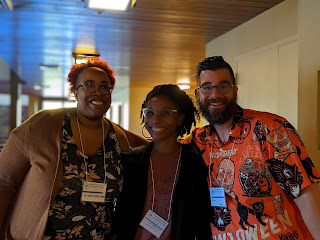Georgia Association of Teacher Educators (GATE) 2022
If no one comes to your presentation...are you still a presenter?
This is the first time in a decade of presenting at educational conferences that literally no one showed up to our session. To be fair, there were a mere 30 people in the opening session: most of which had sessions in the upcoming timeslot or were literally running the conference.
Stephanie Whitlock, a very gifted Math educator and personal friend, and I had set our presentation room up before the opening session. We were here in Helen, Georgia at the Unicoi Lodge for the conference. While our school had paid for the days off to be staff development, we still had to pay the bill for the conference, travel, and lodging. The room had three large tables, and we sat them in six groups of four to play the board game that would be our interactive session. We had game boards, pieces, dice, mini-figures, character sheets, and markers for each group. Whitlock is highly organized.
Our session was on a collaborative project we did last Spring between a tenth grade ELA class and an accelerated pre-calculus class. For as long as I've been teaching I have heard that ELA teachers should collaborate with Social Studies and Science teachers should collaborate with Math. In our breakfast last-minute planning session this morning Whitlock said that what made this different was "how we weren't just supporting each other's content, but actually made what we were already teaching work in both classes."
What Are Our Chances is a narrative writing and statistical probabilities project that is basically a tabletop roleplaying game.
- Students build characters that are actively engaged in surviving the zombie apocalypse
- Students participate in lessons to understand and build probability events that support the development of the boardgame.
- Students then play the boardgame as their character to literally be the character making choies based off of statistical probabilities on what choices they should make to gather supplies and attempt to escape the city.
- Students record these choices on a game sheet, and the outcomes of their dice rolls and events.
- These game sheets determine what happens with the overall outcome of their team. Do the characters live or die?
- These story sheets then drive narrative writing and inspire stories about characters that students literally have experienced through the gift of roleplay.
Despite all of this hard work (mostly Whitlock), we had one person come and sit with us, but we did not get to do our presentation or play the board game. Our goal was to introduce the project and then facilitate the game with each group. My friend Dr. Jones would tell me that these things happen, and while I can hear his voice, I'm still pretty bitter about the missed opportunity to share our work with this conference.
Honestly, the best part of this conference has been meeting other people in GSU's doctoral programs. I have finally met Glenda Chisholm whom Dr. Zoss encouraged me to connect with before. She is a researcher doing YPAR work. Another graduate, Dr. Jamie Daniels-Favors is a teacher educator at Kennesaw State University and a Science educator. Meeting both of them felt a little bit too much to be a coincidence. We spent the day hopping between sessions that they were either presenting at or attending.






Comments
Post a Comment